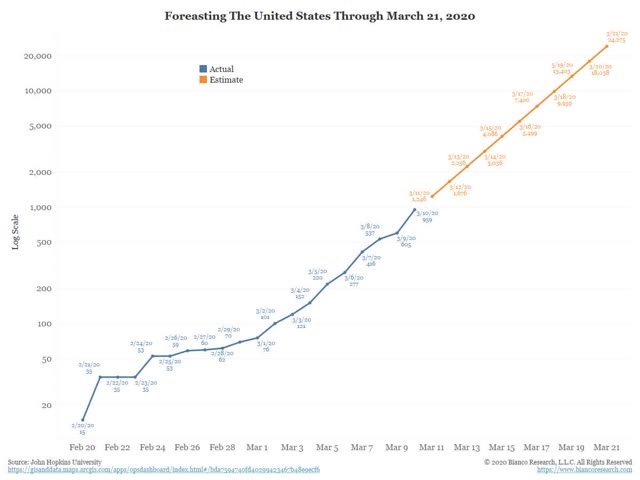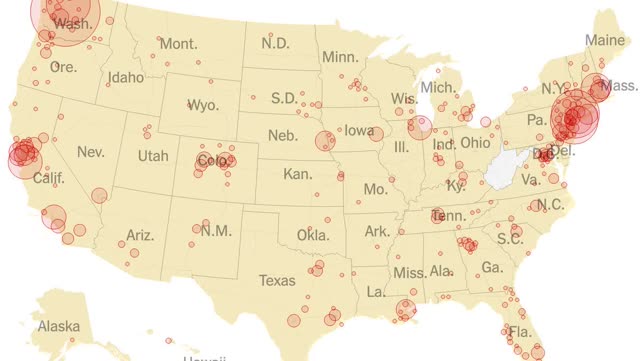This weekend has continued the discouraging news: reports just about everywhere that the Young Invulnerables packed the bars Friday night; the Petri dishes of airport security lines packed with Americans returning from Europe; and personally, two friends who I have known for almost 40 years getting very sick this past week and not able to be tested for coronavirus (one of whom by the way went in to work Friday to drive school buses full of kids because so many other drivers called out). All of these are going to be vectors for continued transmission of the virus.
In that regard, let me repost the graph from Jim Bianco that I ran last week. Because we are now 4 days into his linear projection of an exponential curve of coronavirus transmissions. Here’s the graph:

And here is how his projections compare with the actual numbers I pulled each day from the Johns Hopkins site:
Date Projection Actual
3/11 1246 1326
3/12 1676 1701
3/13 2256 2174
3/14 3036 2952
So far Bianco’s projections have been almost exactly correct.
If reality follows his projections, in 4 days there will be 10,000 cases.
In 7 days there will be 25,000 cases.
I have not seen any government action significant enough to stop this exponential projection being correct.
And by the way, if the diagnoses continue to climb thereafter at the rate of 2.5x every 3 days as shown in Bianco’s graph, here are the next 30 days after March 22:
3/28 62,500 cases
4/3 156,250 cases
4/9 390,000 cases
4/15 977,000 cases
4/21 2.4 million cases
If that is cause for grave alarm, there is at least some reason to suspect that the disease will at least slow it spread, as hotter weather arrives.
Below is a map of coronavirus cases by metro areas in the US:

Note that all of the most affected areas are in the North. Despite LA’s deep economic and immigrant ties to Asia, it is not nearly so affected as San Francisco or Seattle. And despite Florida’s huge elderly population, it is not nearly so affected as New York or Boston.
This is what economists call a “natural experiment.” It will be worth watching to see if the North/South dichotomy continues. *IF* the more optimistic scenario happens, that will give the US 4 to 6 months of relative breathing space to adopt more effective measures, and possibly at least a partially effective vaccine might be developed to be used on those most at risk.
Finally, I should note that I am a fan of K.I.S.S. metrics. They are easy to follow and test, and can yield results close to those of far more sophisticated models.
Also, as I often point out, whenever human behavior is observed, the humans observe back – and change their behavior as a result of their knowledge of what was observed in them previously. If the American public becomes convinced that the epidemic is out of control, they are likely to self-isolate without any government action at all. And that would change the exponential spread.



As Otto von Bismarck noted ““God has a special providence for fools, drunkards, and the United States of America.”
That’s a reason for hope.
But there are multiple reasons for despair (hoarding epidemics has shown how brainwashed people are neoliberal rationality)
The neoliberal society with its twisted guiding philosophy of radical individualism and competition combined with a supremacist “that could never happen here” attitude quickly falls into panicked chaos when reality kicks in and reveals the society’s underlying vulnerabilities.
Countries with weak social safety nets and an ideological opposition to social responsibility are extremely vulnerable to systemic breakdown when their societies are hit with unexpected stress.
That is what we see in the USA. This virus is revealing just how ineffective the neoliberal social Darwinism (“every man for himself”) ethic (aka “neoliberal rationality”) is and how deeply in denial and out of touch with reality these societies are. Including first of all neoliberal politicians (aka Washington swamp rats)
Casino capitalism economics is fragile and huge shocks are possible.
If the virus was deadly across all age groups there is no doubt that the 2020 Darwin Award would go to viewers of Fox News and supporters of Donald Trump, two closely but not perfectly aligned groups. Alas while the older viewers and supporters are the most likely to die they are past their breeding age so the gene pool will not change. I suspect that there is at least a part of the younger Fox News/Trump cohort who think high death rates among older Americans is a feature not a bug and are decidedly put out that they can no longer go to or otherwise watch sporting events and concerts. I have discovered that when standing in a line at a grocery store and young people come up behind me that faking a cough and suggesting they keep a social distance of 6 feet is highly effective. As to closing the taverns, Milwaukee did very well during the so called Spanish Flu by closing the churches but keeping the taverns open. I suppose if the Democratic old people are scrupulous about hygiene, social distancing and hunkering down, it will not matter what the young Trump supporters and Fox News fans do.
This might be why northern Italy has been hit harder than southern Italy.
I have seen humidity also given as a reason for the geographic distribution. Dry air means more spread from aerosols staying airborne longer. Could be a combination of both warmth and humidity, which would explain Florida.
A Facebook friend who is a retired nurse with some connections in China posted something that listed the symptoms and the following suggestion that temperatures that exceed 25 Celsius kills this virus. So let’s hope for an early and hot summer. Of course that only buys a little time before the fall.